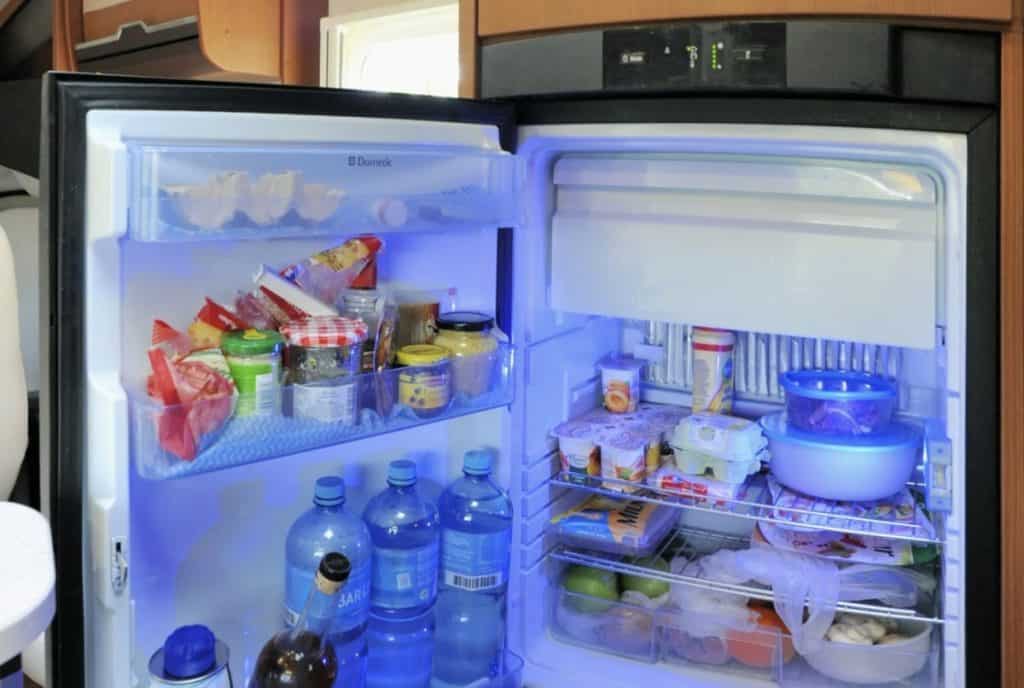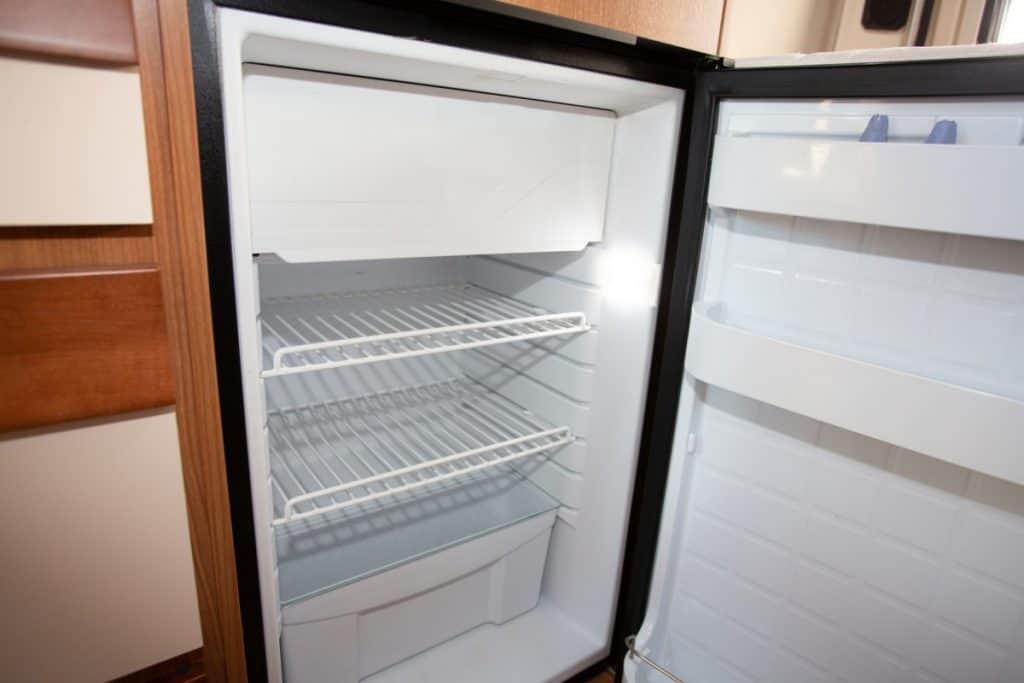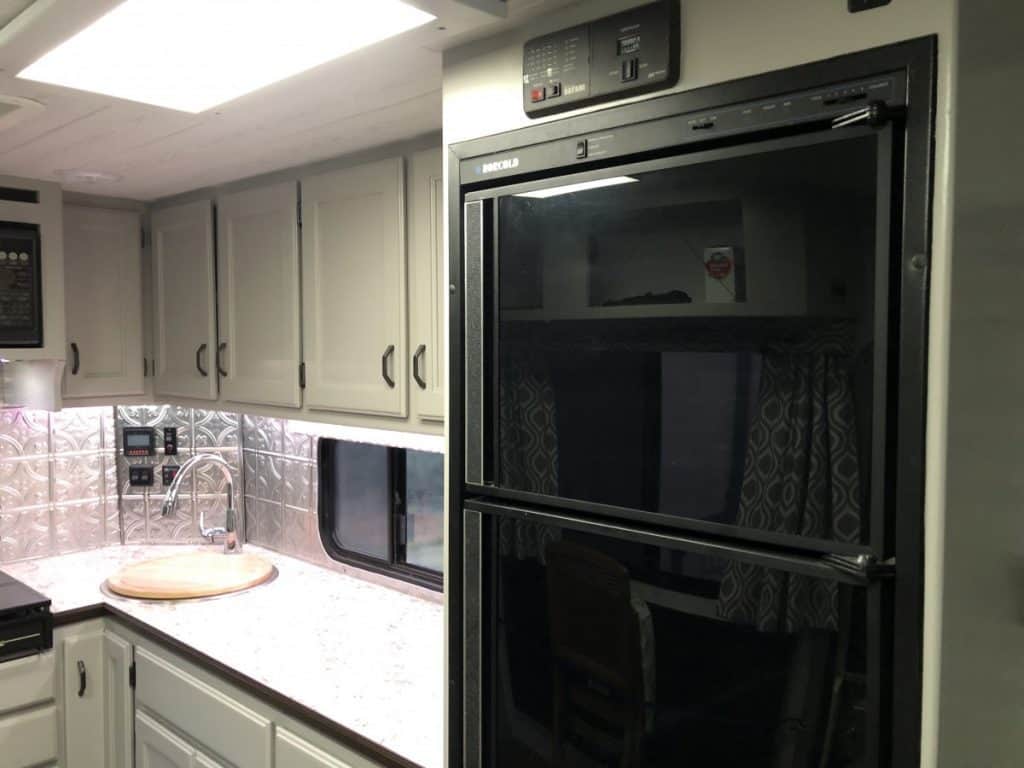This post contains affiliate links.
It goes without saying, but storing food in an RV can be a challenge, especially if you aren’t sure how to properly pack an RV refrigerator.
When it comes to packing a refrigerator on an RV, the goal is to avoid food spoilage and spillage. While this may be a simple task for the fridge in your kitchen, RV refrigerators require a lot of preparation and meticulous organization to do the job right.
Luckily, I’ve compiled a list of tips to ensure your food stays cold and doesn’t spoil or spill while you’re on the open road. Before I dive into packing your RV fridge the right way, let’s help you understand why this is so important.
Table of Contents
Why is Packing an RV Refrigerator Correctly Important?
When staying in a recreational vehicle, it’s crucial to pack the right foods in your RV refrigerator. You also need to organize and store them the right way.
Doing so ensures your food…
- Won’t spoil
- Won’t spill out into your RV
- Is protected against pest infestations
- Is easily accessible
With that said, packing and organizing your RV refrigerator properly can be challenging, especially if you’ve never done it before. We’ll share some tips below to help you

Tips to Properly Pack an RV Refrigerator
Plan Your Meals Ahead
Unless you’re living in your RV on a full-time basis — and, in some cases, even if you are — the first thing you should do is take the time necessary to plan your menu for the entirety of your stay in your RV.
For example, if you’re going to be in your RV for two weeks, then you should have meals planned out for those two weeks.
Appropriate planning can be helpful, as it allows you to take the right amount of food; nothing more, nothing less. This is smart when staying in the confines of a smaller space.
Turn The Refrigerator On Before Packing it
Unlike the fridge in your kitchen, which is constantly running, RV refrigerators need time to get cold.
Powering on your RV fridge and giving it the necessary time to cool down is a crucial step in properly storing food, specifically sensitive products like dairy and meat.
Whether you’re renting an RV or just getting into an RV you own for a long trip, the refrigerator needs to be turned on and cooled down.
I recommend timing your grocery shopping so that you bring food into your RV at least 3-4 hours after the refrigerator has been turned on.
BONUS TIP: Sometimes RV rental agencies will turn the fridge on for you. If this is the case, be sure to check the fridge to ensure it has been properly turned on and is at the right temperature. Learn more about the right temperature for your RV fridge in my article, RV Refrigerator Temperature Guide.

Avoid Overpacking the Fridge
Many first-time RV owners and renters will mistakenly overpack their RV fridges. This is typically done intentionally to ensure you have extra food just in case.
However, overpacking can be a messy (and sometimes even fatal) mistake. This is because overpacking an RV fridge can prevent proper air circulation.
In order for air to circulate properly in an RV fridge, there needs to be enough space between the contents of the fridge itself. The cooling fans inside the refrigerator facilitate the airflow.
To avoid food spoilage, it’s critical to ensure your food products are spaced out enough to allow for the proper air circulation. This will ensure cold food stays cold and prevents bacteria from multiplying.
Keep in mind, it’s not always obvious when food has spoiled. Consuming spoiled food (especially meat and dairy products) can lead to serious illness and sometimes death.
Consider Using Special Storage Containers As Drawers
Most RV refrigerators only have one or two drawers built-in, but you can easily create an entire pull-and-grab system by adding a few storage baskets for added convenience.
The goal is to make the most out of a small space. Being able to pull out a drawer allows you to easily reach items deep in your fridge.
Unfortunately, in order for drawers to work properly, you’ll typically need special glides or slides installed. However, to get around this, you can buy special storage containers (like these ones).
Adding simple containers on your shelf that pull out is an easy way to add “drawers” to your RV’s fridge. Just be sure the storage containers you buy are going to fit correctly by measuring the length, height, and width of the inside of your fridge.
- 【PLEASE NOTE】Please check the size of your refrigerator shelf. If the depth of the refrigerator shelf is smaller than 11.2 inch (28.5...
- 【Adjustable Size】: Drawer size: L 10.8" x W 6.7" x H 3", the upper part has a smooth spring pull rod design, which can freely adjust the...
- 【Unique Design】: The storage box with pull rod design makes full use of the space under the refrigerator glass plate. The internal...
Remove Food From Its Original Packaging
This tip isn’t going to apply to all of the food products you purchase. Some food items are packaged perfectly, in a way that keeps them compact, so these products should be left alone.
With that said, some items you buy will be in packages that contain too much empty space.
While this might work for stocking the food on store shelves, it isn’t ideal for your RV fridge, which needs all the space it can get. This is why it’s wise to remove these items from their original packaging and, instead, store them in sealed containers.
Put Food In Sealed Containers
As I mentioned above, food should be removed from its original packaging when the packaging is full of too much empty space.
Your RV fridge only has so much real estate, and you need to ensure each item is spaced out enough to allow for the proper air circulation.
With this in mind, food items should be placed in sealed containers to save space. I recommend using containers that are square shaped, instead of round, as this will optimize the available space in your fridge.
Sealed containers are ideal for storing your leftovers, but can also come in handy when storing smaller items to keep them all in one place.
Most storage containers on the market have air tight lids and are made of high-quality plastic to ensure your items are as lightweight as possible.
- Food storage containers feature crystal-clear, BPA-free Tritan plastic lids and bases with 360-degree clarity; they help keep food fresh and...
- Built-in vents under latches allow splatter-resistant microwaving with the lid on
- Stain-resistant material keeps plastic food container looking like new, and resists odors
Store Fruit And Vegetables In Mesh Bags
Fruits and vegetables need a different method of storage. Don’t waste your valuable storage containers on them, because that’s actually not the best way to keep them fresh.
Instead, grab some mesh bags like these to keep your produce lasting as long as possible.
Fruits and veggies need air circulation to keep from spoiling, so this is your best option to keep your fridge looking clean and your produce looking fresh.
Be Meticulous When Packing Your Fridge Door
Take advantage of extra storage space that the refrigerator door might provide you with. But, keep in mind that anything in the door might rattle around as you’re driving and place unnecessary pressure on the door hinges.
You can fix this by putting condiments in heavy bottles into lightweight plastic bottles. This can also ensure that you don’t bring more than what you need for your trip. Try this set!
Consider Fridge Braces or Bars
Tired of your food flying everywhere when you hit a bump in the road? Consider buying fridge braces or fridge bars to make sure your food stays put even on the roughest of roads.
This product can be locked around any of your storage containers to ensure they stay in place while driving. What a great idea!
- Keep order in the RV refrigerator and cupboards during travel.Fit Type: Universal Fit
- Spring loaded bars keep items in place
- Refrigerator bars extend from 16" to 28"
Don’t Place Hot Food in your RV Fridge
Placing hot or warm food in your RV fridge makes it work extra hard to stay cool. It now needs to cool down all that heat that you have added to your fridge.
Let leftovers cool down before placing them in your fridge. Consider using a freezer pack to cool it faster. Also when you are packing your fridge putting already cold or frozen food into your fridge and freezer will help it stay cold.
Remove The Ice Maker in Your Freezer
Some higher end RVs have an ice maker in the freezer. Optimize the space in your freezer by getting rid of that bulky ice machine! I know, I know – everyone likes fresh ice in their water on a hot day on the road.
Utilize ice trays like these instead to get cold ice without taking up that precious freezer space. This one is silicone which makes it easy to remove the cubes and is lightweight and flexible for storage purposes. As an added bonus it has a lid, so you can easily stack things on top of it.
You can use that freezer space instead to keep extra food when you won’t have a chance to go to the grocery store. This is also a good space to keep quick and easy frozen meals when you won’t have the time to cook a full meal.
Ensure The Refrigerator Door is Closed And Secured
Lastly, make sure you’re keeping that refrigerator door closed whenever you can. It’s important to ensure the fridge stays cold so your food doesn’t spoil.
RV refrigerators do come with latches to make sure they stay closed on those bumpy roads, so just use that latch every time and you should be good to go.
Nobody likes food flying out of their fridge. This can be messy, gross, and cause unpleasant odors inside your RV.

Frequently Asked Questions
How much room will my RV fridge provide?
You might be wondering how much storage space you’re actually going to have in your RV refrigerator. That answer may vary based on the size of your RV.
RVs come with their own fridge already pre-installed, so you won’t have to worry about purchasing one yourself. However, this will definitely be something you want to look at when deciding on an RV model.
RV fridges range in size from as small as 1.7 cubic feet up to as big as 18 cubic feet. The average RV refrigerator will be between 5.3 cubic feet and 12 cubic feet.
Smaller less expensive rigs will usually have smaller fridges. The bigger high end Class A RVs can have fridges up to 18 cubic feet. Check out this picture from Norcold to more clearly understand how much space that will give you.
No matter what storage space you’ll be working with, we know you’ll be able to tackle your food storage easily with these tips. Just remember to plan ahead, buy storage materials if needed, and get ready for an exciting adventure!
What’s the difference between an RV refrigerator and my fridge at home?
Most RV refrigerators are absorption refrigerators whereas home fridges are compressor refrigerators. These two fridges operate very differently.
An absorption fridge works through the heating and cooling of ammonia either by a propane heating element or an electrical heating element. RV absorption fridges can be two-way or three-way fridges. A two-way fridge can be run on propane or by A/C power. A three-way fridge can be run by propane, A/C power, or D/C power.
Learn more about how RV fridges function by reading this article.
A household fridge works using a compressor and needs A/C power to run.
Another difference is the RV refrigerator is much smaller than the fridge in your kitchen. Thus, you need to carefully pack your RV fridge to make the most out of the smaller space.
Food should be spaced out properly to allow for the proper air circulation and should be stored in tightly sealed containers instead of its original packaging.
Additionally, your fridge at home runs 24/7. An RV fridge, on the other hand, needs to be turned on before you use it so it has an adequate amount of time to cool down.
Food stored at improper temperatures can go bad quickly. At that point, you’ll be forced to throw your food away, which means money down the drain.
If you’re renting an RV, the rental agency may turn your fridge on for you, but this isn’t always the case. This is why you should check your fridge to make sure it has been cooled down properly.
How much time does an RV fridge need to cool down?
After turning on your RV fridge, you should allow it to cool down for at least 3-4 hours. Letting it cool overnight is preferred.
This will ensure your food stays cold and doesn’t spoil. Rotten food can cause foul odors and attract vermin (such as insects and rodents).
It also helps to place already cold or cooled food in your fridge. Then the fridge doesn’t need to work as hard to stay cold.
Can I install a residential fridge in my RV?
Those who live in their RVs or motorhomes on a full-time basis will oftentimes have residential refrigerators installed. This is because they are usually stationary and can guarantee they will have A/C power at all times.
However, if you’re only using your RV on a part-time basis, for short trips, then a traditional RV fridge will work just fine. Especially if you follow the tips outlined in this article.
What does an RV fridge run on?
Standard compressor-drive RV fridges are generally run by AC power or by DC power. This means you can run your fridge off of shore power when your RV is plugged in, or off of your coach batteries if it is not plugged in.
Absorption RV fridges run on either propane, AC power or DC power. If your RV is plugged into shore power or running off the generator then it will use AC power. When your RV is unplugged it will use propane or DC power from your coach batteries depending on your model.
Learn more about how RV fridges function by reading this article.
Final Thoughts
As you can see, knowing how to properly pack an RV refrigerator is crucial when it comes to fitting everything inside in a convenient way. Packing your fridge properly is also important for avoiding food spoilage, spills, and pest infestations.
At the end of the day, you want your RV trip to be an enjoyable one. By following the tips listed above, you’ll be able to conveniently enjoy meals on the road without worrying if your food is going to spoil or not.



